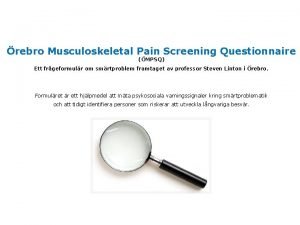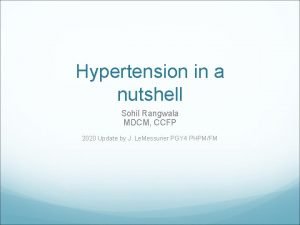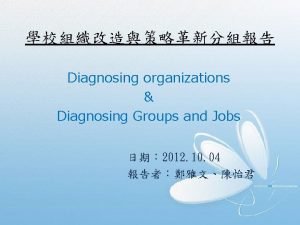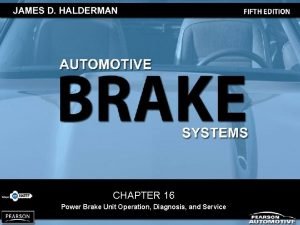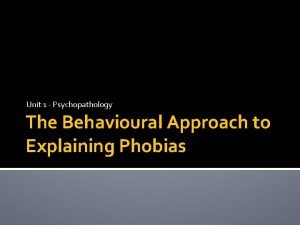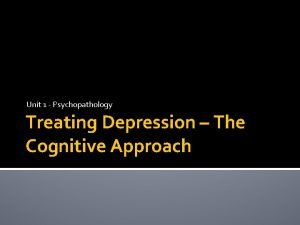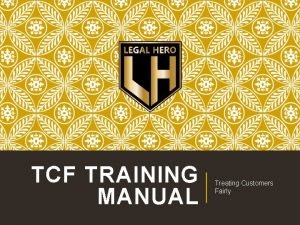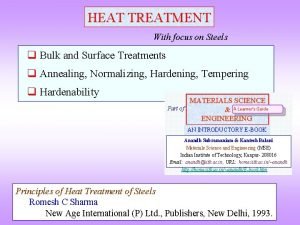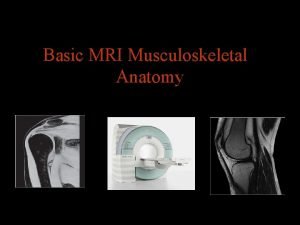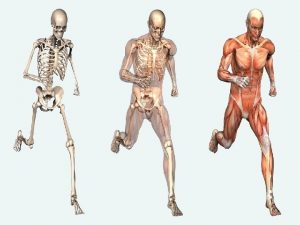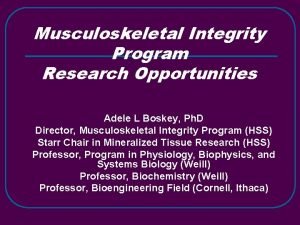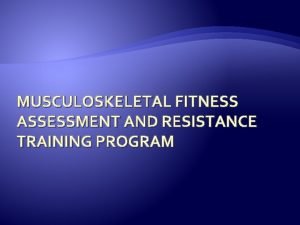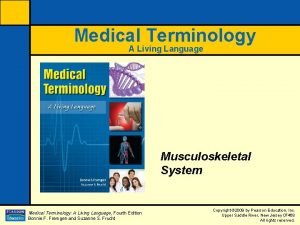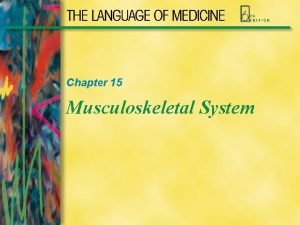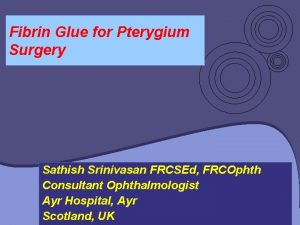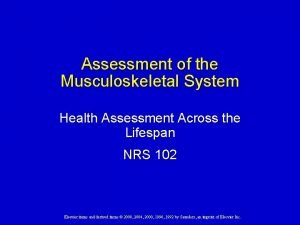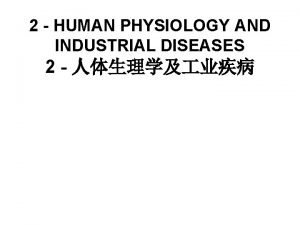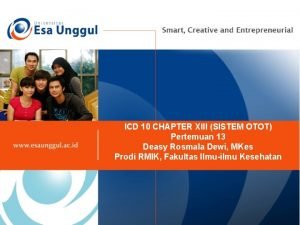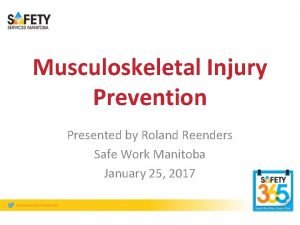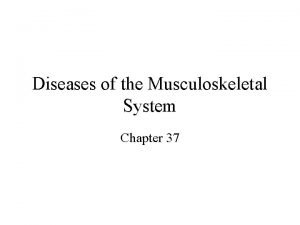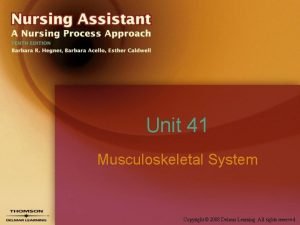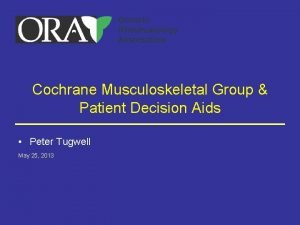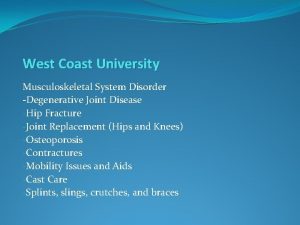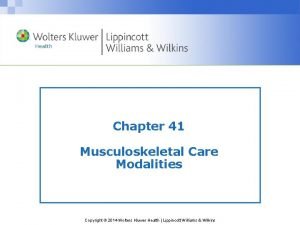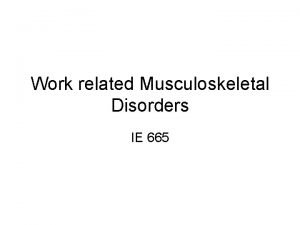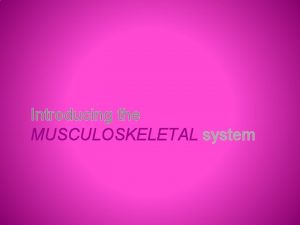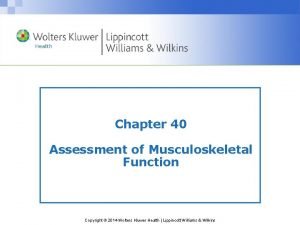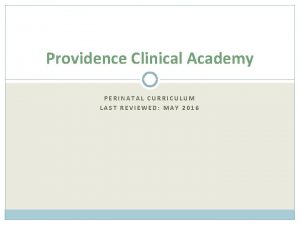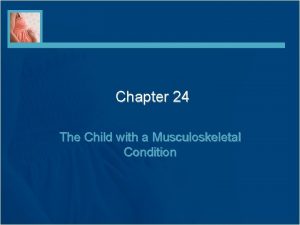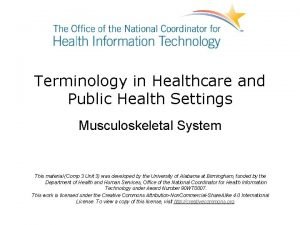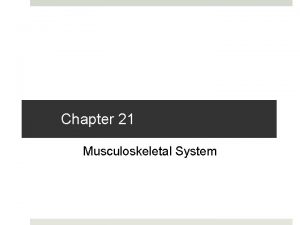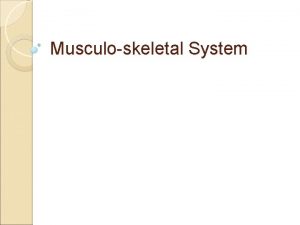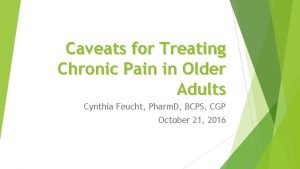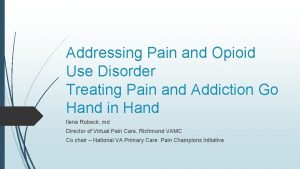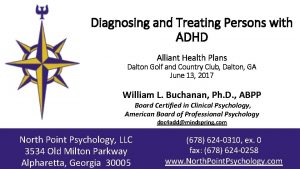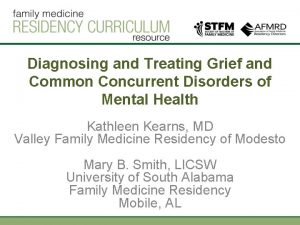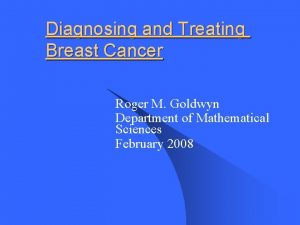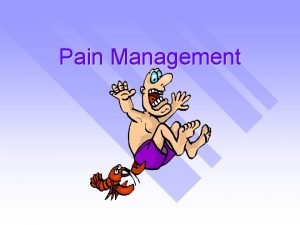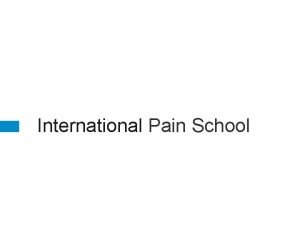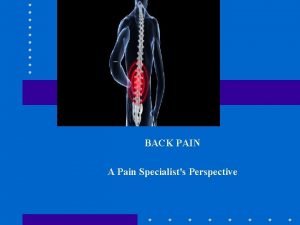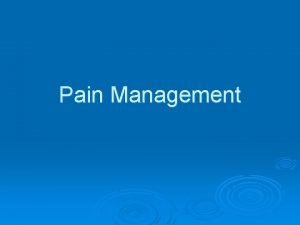Diagnosing Treating Musculoskeletal Pain In WorkingAged Adults The






















































- Slides: 54

Diagnosing & Treating Musculoskeletal Pain In Working-Aged Adults The Importance of Identifying The Central Pain Phenotype 5/6/17 Presented By: Daniel Clauw, MD Paul Coelho, MD 1

Disclosures: Dr. Clauw Consulting Pfizer, Forest, Eli Lilly, Pierre Fabre, Cypress Biosciences, Wyeth, UCB, Astra Zeneca, Merck, J&J, Nuvo, Jazz, Abbott, Cerephex, Iroko, Tonix, Theravance, Samumed, Zynerba, Aptinyx Research Support Pfizer, Cypress Biosciences, Forest, Merck, Nuvo, Cerephex Dr. Coelho Has no disclosures. He will not be discussing any off-label uses of medications or devices. 2

Table of Contents Early Pain Models Modern Pain Models FMS, HA, and LBP The Central Pain Phenotype Sample Case Evidence-Based Treatments 3

1980 Model of MSK Pain Nociceptive Neuropathic Primarily due to inflammation or Damage or entrapment of tissue damage in the periphery peripheral nerves. NSAID/Opioid Responsive Responds to both peripheral and central pharmacotherapy. Responds to procedures. Does not respond to procedures. Behavioral factors minor. Examples: Osteoarthritis, Rheumatoid arthritis, cancer pain. Examples: Diabetic peripheral neuropathy, post-herpetic neuralgia. http: //www. ncbi. nlm. nih. gov/pmc/articles/PMC 1829161/ 4

1990 FMS https: //www. rheumatology. org/Portals/0/Files/1990_Criteria_for_Classification_Fibro. pdf 5

US Overdose Deaths 1980 -2014 Peak Incidence of Prescription OD 45 -54 50000 Portenoy Recants 2012 IOM 100 M In Pain 2011 th APS Pain as a 5 Vital Sign 1996 37500 FDA Approves Oxy. Contin 1995 Wolfe ACR FMS 1990 Portenoy/Foley 1986 Porter & Jick 1980 25000 12500 0 1983 1986 1989 1992 1995 1998 2001 2004 2007 2010 2013 http: //www. ncbi. nlm. nih. gov/pmc/articles/PMC 1829161/ 6

Variation in Opioid Rx’ing for FMS 2007 -2009 Peak Incidence of Prescription OD 45 -54 http: //www. ncbi. nlm. nih. gov/pmc/articles/PMC 4346177/ 7

35% of FMS Pt’s Receive SSDI Disabled Medicare Beneficiaries Rx’d Opioids https: //www. ncbi. nlm. nih. gov/pmc/articles/PMC 4151179/ 8

FMS Patients Report High Pain Levels In Spite of High Dosages N = 582 https: //www. ncbi. nlm. nih. gov/pubmed/24310048 9

Opioids In FMS: Once Started Seldom Stopped N = 100 K, 60% Received Opioids. https: //www. ncbi. nlm. nih. gov/pubmed/26443495 10

Opioids In FMS: Once Started Seldom Stopped N = 64 K, 44% Received Opioids. https: //www. ncbi. nlm. nih. gov/pmc/articles/PMC 5117947/ 11

30 Day Supply & Risk of COT 20% will remain on opioids at 3 yrs. https: //www. cdc. gov/mmwr/volumes/66/wr/mm 6610 a 1. htm 12

FMS Is Not Opioid Responsive Organization American Pain Society American Academy of Pain Medicine American Academy of Neurology European League Against Rheumatism Canadian Pain Society Canadian Rheumatology Association British Pain Society https: //www. ncbi. nlm. nih. gov/pubmed/26975749 13

2017 Model of MSK Pain Nociceptive Neuropathic Central Primarily due to inflammation or tissue damage in the periphery Damage or entrapment of peripheral nerves. Primarily due to a central disturbance in pain processing. NSAID/Opioid Responsive Responds to both peripheral and central pharmacotherapy. Tricyclic neuro-active compounds. Opioid unresponsive. Responds to procedures. Does not respond to procedures. Behavioral factors minor. Behavioral Factors Prominent. Examples: Osteoarthritis, Rheumatoid arthritis, cancer pain. Examples: Diabetic peripheral neuropathy, post-herpetic neuralgia. Examples: FMS, c. LBP, c. HA, IBS. http: //www. ncbi. nlm. nih. gov/pmc/articles/PMC 1829161/ 14

Comorbid Pain in FMS is the Norm “Overwhelming evidence reveals that what is often labeled as a single chronic regional pain syndrome is, upon closer evaluation, a chronic illness beginning much earlier in life, where the pain merely occurs at different points of the body at different points in time and is given different Low Back Pain labels by subspecialists focusing on “their region” of the body. ” Daniel Clauw, MD https: //www. ncbi. nlm. nih. gov/pubmed/22364327 15

Prevalence of LBP & HA in 2007 Internet. FMS Survey of 2596 FMS Pts Ave Age = 47 If due to chance alone LBP. 3 x. 05 =1. 5% HA: . 2 x. 05 =1% https: //www. ncbi. nlm. nih. gov/pmc/articles/PMC 1829161/ 16

Prevalence of LBP & HA in FMSFMS+ N = 2, 934, 441 https: //www. ncbi. nlm. nih. gov/pubmed/27281286/ 17

Prevalence of FMS in c. LBP 42% Chance Alone: . 3 x. 05 = 1. 5% https: //www. ncbi. nlm. nih. gov/pmc/articles/PMC 1829161/ 18

Prevalence of FMS in Migraineurs 56% N = 1, 730 Chance Alone: . 2 x. 05 += 1% https: //www. ncbi. nlm. nih. gov/pubmed/25994041 19

Head Ache & LBP Predict FMS https: //www. ncbi. nlm. nih. gov/pubmed/26772544 20

Comorbid Pain in FMS is the Norm Fibromyalgia Low. Back. Pain Head Ache https: //www. ncbi. nlm. nih. gov/pubmed/22364327 21

Central Sensitivity Spectrum Disorders https: //www. ncbi. nlm. nih. gov/pubmed/17350675 22

Overlapping Chronic Pain Conditions https: //www. ncbi. nlm. nih. gov/pubmed/27586833 23

Prescribers are Poor at Diagnosing Central Pain Syndromes 23% Sensitivity N = 312, 240 FMS+ https: //www. ncbi. nlm. nih. gov/pubmed/23071343 24

Prescribers are Poor at Diagnosing Central Pain Syndromes 27% Specificity N = 4 M https: //www. ncbi. nlm. nih. gov/pubmed/27281286 25

Prescribers are Poor at Diagnosing Central Pain Syndromes “You cannot guess at the extent of fatigue, unrefreshed sleep, cognitive problems, multiplicity of symptoms, and extent of pain without a detailed interview. The new criteria obligate you to pay careful attention to the patient if you want to diagnose fibromyalgia. ” Fredrick Wolfe https: //www. ncbi. nlm. nih. gov/pubmed/20461781 26

Diagnosing Central Sensitivity Spectrum Disorders 1. Pain in many body regions. 2. Higher current and lifetime history of chronic pain in several body regions. 3. Multiple somatic symptoms (e. g. , fatigue, memory difficulties, sleep problems, mood disturbance) 4. Negative Affect, dispositional pessimism, pain catastrophizing. (Stable trait vs transient state) 5. More sensitive to other sensory stimuli (e. g. , bright light, loud noises, odors, other sensations in internal organs) 6. 1. 5 to 2 x more common in women. 7. Strong family history of chronic pain. 8. High self-reported pain & distress (VAS/NPS/PSD/PCS) 9. Pain triggered or exacerbated by stressors. 10. Peak prevalence of FMS age 30 -59 (working-age). * 11. Essentially normal physical examination +/- diffuse tenderness. https: //www. ncbi. nlm. nih. gov/pubmed/26266995 27

2016 FMS Survey Questionnaire 96% Sensitivity, 92% Specificity https: //www. ncbi. nlm. nih. gov/pubmed/21285161 28

Pain Catastrophizing Scale Moderate Risk 20 -29 High Risk > 30 https: //www. ncbi. nlm. nih. gov/pubmed/11289089 29

Elevated PCS Predicts Abuse https: //www. ncbi. nlm. nih. gov/pubmed/23618767 30

Elevated PCS Predicts Abuse https: //www. ncbi. nlm. nih. gov/pubmed/24612286 31

Elevated PCS Predicts Abuse https: //www. ncbi. nlm. nih. gov/pubmed/23809983 32

Why Is Dx’ing FMS/CSS Important? 1. It is opioid unresponsive. 2. Once opioids are started FMS/CS patients are exquisitely sensitive to withdrawal symptoms & thus hard to taper. 3. Guessing at the Dx makes for poor inter-rater reliability. 4. Prognosis: Untreated it does not improve with time. 5. When present amid other CNP conditions – HA, LBP, etc. – it is likely to be the primary source of morbidity. 6. Patient expectations for treatment are often unrealistic. 7. Provider satisfaction/comfort with care is low. 33

FMS Is Opioid Unresponsive https: //www. ncbi. nlm. nih. gov/pubmed/26975749 34

Natural Hx of FMS N = 1, 555 11 yr f/u https: //www. ncbi. nlm. nih. gov/pubmed/21765102 35

Natural Hx of FMS N = 76 2 yr f/u https: //www. ncbi. nlm. nih. gov/pubmed/28077978 36

Natural Hx of FMS N = 1, 644 https: //www. ncbi. nlm. nih. gov/pubmed/23710561 37

FMS is the Primary Source of Morbidity in Mixed Pain States N = 383, 76 FMS+ https: //www. ncbi. nlm. nih. gov/pubmed/27049402 38

FMS is the Primary Source of Morbidity in Mixed-Pain States N = 156, 25 FMS+ https: //www. ncbi. nlm. nih. gov/pubmed/28182837 39

FMS is the Primary Source of Morbidity in Mixed Pain States N = 172 38 + FMS https: //www. ncbi. nlm. nih. gov/pubmed/28229811 40

Patient Expectations In FMS N = 248 https: //www. ncbi. nlm. nih. gov/pubmed/19732374 41

Provider Satisfaction https: //www. ncbi. nlm. nih. gov/pmc/articles/PMC 4070226/figure/Fig 1/ 42

Sample Case 43

Joyce is a 45 y/o woman who recently moved from CA to Jackson, County to retire. Her past medical history is significant for a work related back injury for which she was medically retired. She now receives SSD and seeks to establish care with you for primary care needs as well as pain management. Her medication regimen consists of Lisinopril for HTN. She is requesting “Percocet” for pain. 44

Joyce 10 >13 = FMS 7 >13 = FMS 45 17

Joyce 4 4 3 4 4 48/52 >30 Abnl 46

Evidence-Based Treatments of FMS Treatment Evidence Level Patient Education 1 A Graded Exercise 1 A CBT 1 A Tricyclics 1 A SNRI’s 1 A Gabapentenoids 1 A NSAIDS 5 D Opioids 5 D https: //www. ncbi. nlm. nih. gov/pubmed/28077978 47

Centralized Pain Pt Handout https: //www. painscience. com/articles/central-sensitization. php 48

Evidence-Based Treatments for FMS https: //www. youtube. com/watch? v=pg. Cfk. A 9 RLr. M 49

Evidence-Based Treatments for FMS https: //fibroguide. med. umich. edu/ 50

Evidence-Based Treatments for Pain Catastrophizing 51

Evidence-Based Treatments for Pain Catastrophizing https: //web. stanford. edu/class/msande 271/onlinetools/Learned. Opt. html 52

Resources 2016 Fibromyalgia Survey Questionnaire https: //www. slideshare. net/101 N/2016 -fibromyalgia-surveyquestionnaire Evidence-Based Treatments for FMS, Dr. Clauw JAMA http: //www. slideshare. net/101 N/fibromyalgia-clinical-review Daniel Clauw, MD Youtube Video for patients https: //www. youtube. com/watch? v=pg. Cfk. A 9 RLr. M&t=6 s Sample Centralized Pain Patient Handout http: //www. slideshare. net/101 N/central-sensitization-70569194 List of non-opioid alternatives for chronic non-cancer pain http: //www. slideshare. net/101 N/nonopioid-alternatives-for-chronicnoncancer-pain 53

paul. coelho@salemhealth. org 54
 örebro musculoskeletal pain screening questionnaire
örebro musculoskeletal pain screening questionnaire Diagnosing hypertension
Diagnosing hypertension Group level diagnostic model
Group level diagnostic model Diagnosing error in object detectors
Diagnosing error in object detectors Unit 5 quiz 1 power assist systems
Unit 5 quiz 1 power assist systems Rheumatoid nodules
Rheumatoid nodules Aobp vs obpm
Aobp vs obpm Diagnosing your cultural intelligence
Diagnosing your cultural intelligence Lewis mad pain and martian pain
Lewis mad pain and martian pain Pms or pregnancy
Pms or pregnancy Is pregnancy pain same as period pain
Is pregnancy pain same as period pain Chapter 24 lesson 2 preventing and treating stds
Chapter 24 lesson 2 preventing and treating stds Chapter 4 ethics and social responsibility
Chapter 4 ethics and social responsibility Tumor treating fields mechanism of action
Tumor treating fields mechanism of action Mowrer two process model
Mowrer two process model Cognitive approach to treating depression
Cognitive approach to treating depression Tcf training
Tcf training Ethical issues in treating lgbt patients
Ethical issues in treating lgbt patients Bulk heat treatment
Bulk heat treatment Chapter 6 musculoskeletal system diseases and disorders
Chapter 6 musculoskeletal system diseases and disorders Musculoskeletal
Musculoskeletal Mri
Mri Muscle strength scale
Muscle strength scale Contoh soal koding icd 10
Contoh soal koding icd 10 Musculoskeletal integrity
Musculoskeletal integrity Musculoskeletal fitness test
Musculoskeletal fitness test Medical term for top of foot
Medical term for top of foot Chapter 15 musculoskeletal system practical
Chapter 15 musculoskeletal system practical Musculoskeletal surgery ayr
Musculoskeletal surgery ayr Objective data for musculoskeletal system
Objective data for musculoskeletal system Musculoskeletal system
Musculoskeletal system Kode icd 10 gout arthritis
Kode icd 10 gout arthritis Chapter 21 the musculoskeletal system
Chapter 21 the musculoskeletal system Thank you pictures for presentation
Thank you pictures for presentation Diseases of the musculoskeletal system
Diseases of the musculoskeletal system Unit 41 musculoskeletal system
Unit 41 musculoskeletal system Cochrane musculoskeletal group
Cochrane musculoskeletal group West coast musculoskeletal
West coast musculoskeletal Chapter 40 musculoskeletal care modalities
Chapter 40 musculoskeletal care modalities Work related musculoskeletal disorders definition
Work related musculoskeletal disorders definition Types of joint movement
Types of joint movement Musculoskeletal
Musculoskeletal Assessment of the musculoskeletal system
Assessment of the musculoskeletal system Musculoskeletal system
Musculoskeletal system Subcostal retractions
Subcostal retractions Chapter 24 the child with a musculoskeletal condition
Chapter 24 the child with a musculoskeletal condition Musculoskeletal pronounce
Musculoskeletal pronounce Mật thư anh em như thể tay chân
Mật thư anh em như thể tay chân Các châu lục và đại dương trên thế giới
Các châu lục và đại dương trên thế giới Tư thế worm breton là gì
Tư thế worm breton là gì ưu thế lai là gì
ưu thế lai là gì Thẻ vin
Thẻ vin Tư thế ngồi viết
Tư thế ngồi viết Cái miệng xinh xinh thế chỉ nói điều hay thôi
Cái miệng xinh xinh thế chỉ nói điều hay thôi Các châu lục và đại dương trên thế giới
Các châu lục và đại dương trên thế giới
